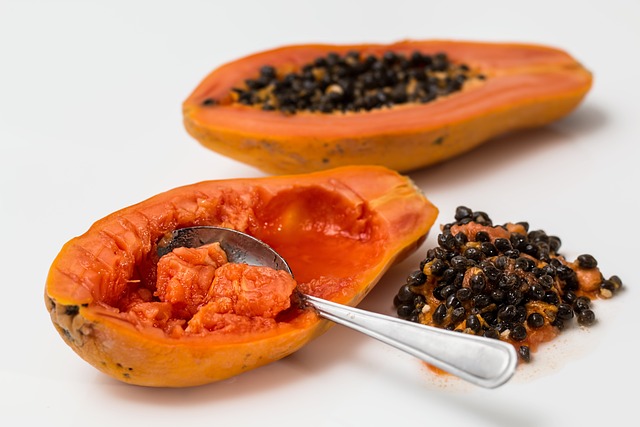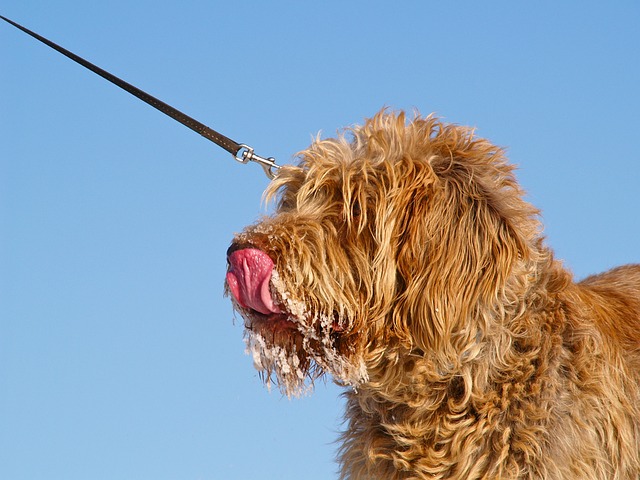
A sweet and colourful snack, papaya is often considered a healthy treat for humans, but can dogs eat papaya as well? The answer is yes, it is generally okay for to dogs eat papaya and enjoy its juicy and refreshing crunch, however, there are certain precautions to take if you want to ensure your pup can enjoy this treat safely. This article explores the health benefits of papaya and some important precautions and ways to serve papaya to your canine friend.
Table of Contents
Is Papaya Safe for Dogs?
Dogs can eat papaya, and it is generally safe for them, but there are several precautions a pet owner should consider:
- Seeds and Skin: Papaya seeds pose a choking hazard and contain traces of cyanide. Although the skin is not toxic, it is tough to digest, so it’s best to always remove seeds and skin before feeding papaya to your dog.
- Moderation: Papaya is a treat and so it should only make up a small percentage (around 10%) of a dog’s daily caloric intake.
- Possible Allergies and Sensitivities: Introduce papaya to your dog’s diet slowly and watch for any signs of allergies or stomach upset. Always consult a vet before adding any new food to your dog’s diet.
How Much Papaya Can Dogs Eat?
When feeding papaya to dogs, portion control is crucial to prevent gastrointestinal upset and ensure that it remains a healthy treat rather than a regular occurrence in your dog’s diet. The amount of papaya a dog can safely eat largely depends on their size. Here’s a rough guideline:
- Extra Small Dogs (<10 lbs): For very small dogs, a small amount of papaya is sufficient. This is around less than a teaspoon’s worth.
- Small Dogs (10-25 lbs): Small dogs can have slightly larger amounts. A safe measure would be about one teaspoon or less of papaya.
- Medium Dogs (25-60 lbs): Medium-sized dogs can enjoy approximately 1 tablespoon of papaya. This should be given in moderation and not as a regular part of their diet.
- Large Dogs (60-100 lbs): Large dogs can typically have around 1-2 tablespoons of papaya. Always be sure you are monitoring their reactions.
- Giant Dogs (100+ lbs): For giant breeds, around 2-3 tablespoons can be offered. However, start small and eventually increase gradually to ensure they can tolerate it.
Remember, these amounts should not be given daily. Also, it’s crucial to introduce any new food slowly into your dog’s diet and monitor for any adverse reactions. Remember to remove the seeds and skin of the papaya before feeding it to your dog, and consult with a veterinarian before adding it to your dog’s diet.
Nutritional Benefits of Papaya for Dogs
Papaya is not just a tasty treat; it’s also packed with nutritional benefits for dogs. Here are some key nutrients found in papaya that are beneficial for dogs:
- Vitamin Rich: Papaya is rich in vitamins and minerals, such as magnesium, vitamin A, vitamin C, and vitamin E. All of these are crucial for a dog’s immune system function, skin health, and eye health. It also contains large amounts of potassium and calcium, both of which support a dog’s general health.
- Fiber: This fruit has a high fiber content, which helps with a dog’s digestion and prevents constipation.
- Enzymes: Papain is an enzyme found in papaya, and it helps with digesting proteins and can aid dogs who have sensitive stomachs.
How to Feed Papaya to Dogs
Papaya can be a healthy treat option to feed to your dog, but it should be done safely and in moderation. Here are some ways you can ensure you’re feeding papaya to your dog in a safe manner:
- Choose Ripe Papaya: Go for a ripe papaya, it is often softer and easier for dogs to digest.
- Wash Thoroughly: Wash the papaya thoroughly to remove any contaminants from the skin.
- Remove the Skin and Seeds: Always remove the papaya skin and seeds before feeding papaya to your dog. The skin is difficult for dogs to digest and the seeds can be a choking hazard and may contain traces of cyanide, which can be dangerous in large doses.
- Cut into Appropriate Sizes: Slice the papaya into small pieces to avoid the risk of choking and to make it manageable for your dog to eat.
- Introduce Slowly: Offer your dog papaya slowly and in small amounts to see how they react. Some dogs may have an allergy or have sensitive stomachs. Monitor your dog after feeding them papaya for any signs of adverse reactions such as diarrhea or vomiting and contact your vet if these occur.
- Moderation is Key: Papaya is meant to be a treat, not a staple in your dog’s diet. Therefore, it should not make up more than 10% of your dog’s total calories for the day.
- Avoid Additives: If using canned papaya, check that it doesn’t contain added sugars or preservatives, which can be harmful to dogs.
- Mix with Other Foods: You can also introduce papaya to your dog’s food slowly by mixing papaya with their regular food or with other fruits and vegetables that are safe for dogs.
By following these guidelines, you can safely incorporate papaya into your dog’s diet as a tasty and nutritious treat. But remember, before introducing your dog to any new food, like papaya, always check with your veterinarian first.

Allergies
As with any food, dogs could have an allergy to papaya. If they do, there are several symptoms that may arise. Here are some signs and symptoms to look out for if you suspect your dog may be allergic to papayas:
- Gastrointestinal Upset: This may include an upset stomach, or other symptoms like vomiting and diarrhea, or for some dogs, even a lack of appetite.
- Skin Irritations: Look for signs like itching, redness, hives, or rashes.
- Paw Licking or Chewing: Dogs might overly lick or chew their paws because of an allergic reaction.
- Ear Infections: Symptoms like itchy ears, head shaking, or a strong odour from the ears may also indicate a food allergy.
- Respiratory Symptoms: Though less common, some dogs may exhibit symptoms such as sneezing, wheezing, or coughing.
- Anaphylaxis: Although it is rare, a severe allergic reaction called anaphylaxis can occur. It is characterized by difficulty breathing, swelling of the face or extremities, and a drop in blood pressure. Immediate veterinary attention is required.
- Behavioural Changes: Discomfort from allergies can lead to changes in behaviour, such as increased agitation, restlessness, or lethargy.
- Eye Irritations: Some dogs might display signs of eye irritation, such as swelling, redness, or discharge.
If you notice any of these symptoms after feeding your dog papaya, it’s important to stop feeding them the fruit and consult with your veterinarian. They can help advise the best course of action for your dog, which may include an elimination diet to pinpoint the exact cause of the allergic reaction.
FAQ
Can Dogs Eat Papaya Seeds?
It is not recommended for dogs to eat papaya seeds because they contain small amounts of cyanide, which can be very harmful if consumed in large quantities. The seeds can also present a choking hazard for dogs or cause intestinal blockage, so it is best to avoid feeding them to your pet.
Can Dogs Eat Papaya Leaves?
Feeding papaya leaves to dogs is not recommended. While papaya fruit can be a healthy snack for dogs when prepared properly (seedless and peeled), the leaves of the papaya plant are a different matter. They contain certain compounds and enzymes that can be difficult for dogs to digest and may lead to gastrointestinal upset, such as vomiting or diarrhea. Moreover, the fibrous nature of leaves can be tough on a dog’s digestive system. For these reasons, it’s advisable to stick to safer, well-known treats and foods that are proven to be safe for canine consumption.
Can Dogs Eat Papaya Skin?
Papaya skin is not recommended for dogs to eat. The skin of a papaya can be difficult for dogs to digest and may lead to gastrointestinal upset, such as diarrhea or vomiting. Additionally, the texture and roughness of the skin could potentially cause choking or an intestinal blockage, especially in smaller dogs. When feeding your dog papaya, it’s always best to peel the fruit and remove the seeds. As with any new food, introduce papaya (minus the skin and seeds) to your dog’s diet in small quantities and observe for any adverse reactions. Always consult with your veterinarian if you have concerns about introducing new foods to your dog’s diet.
Can Dogs Eat Dried Papaya?
You could feed dried papaya to your dog, but it should be given in moderation, and be free from added sugars and preservatives, and done with caution. Always start with a small amount to see how your dog reacts, and consult with your veterinarian first.
Here are some important precautions to keep in mind:
– Sugar Content: Dried fruits, including papaya, often are higher sugar than fresh fruit. Excessive sugar could lead to eventual obesity, dental problems, and diabetes in dogs. It’s crucial to choose dried papaya that doesn’t have added sugars.
– Portion Size: Given the higher sugar content and concentrated nature of dried fruits, the portions should be much smaller compared to fresh papaya.
– Choking Hazard: The texture of dried papaya can be tough and chewy, which can be a choking hazard, especially for small dogs. Always cut the dried papaya into small, manageable pieces.
– Preservatives: Some dried papayas are treated with preservatives and chemicals that can be harmful to dogs, causing stomach upset or allergic reactions. Opt for organic or preservative-free options.
– Digestibility: Dried fruits are harder to digest, which can lead to gastrointestinal issues in some dogs.
– Allergies and Sensitivities: As with any new food, introduce dried papaya slowly to your dog’s diet to monitor for any adverse reactions, such as allergies or digestive issues.
– Hydration: Dried fruits can dehydrate your pet. Ensure your dog has plenty of water when feeding them dried papaya.
Are Papayas Toxic for Dogs?
Papaya’s are generally not considered toxic for dogs, and they can enjoy small pieces in moderation, as long as they are peeled and the seeds are removed. However, your dog’s individual needs may differ and you should consult a vet before introducing your dog to any new foods.
Is Papaya a Laxative for Dogs?
Papaya can have a mild laxative effect on dogs, mainly because it is so high in dietary fiber. However, while this can be beneficial for dogs with constipation, moderation is key. Feeding too much papaya can lead to the opposite problem – diarrhea. Therefore, it’s important to introduce papaya into a dog’s diet gradually and in small quantities, especially if the dog is not used to having so much fiber. As with any dietary change, it’s advisable to consult with a veterinarian, particularly if your dog has a history of digestive issues. They can provide guidance on the appropriate amount of papaya to give, depending on your dog’s size, health status, and dietary needs.
Recipes
Here are some dog-friendly papaya recipes that you can try at home, always remove the seeds and skin first.
Remember, treats should only make up a small portion of your dog’s diet, and start with small amounts to gauge your dog’s reaction. Consult with your veterinarian before introducing new foods into their diet and adjust portion sizes according to your dog’s personalized needs.
1. Fresh Papaya Cubes
- Peel and remove the seeds from a ripe papaya.
- Cut into small, bite-sized cubes suitable for your dog’s size.
- Serve fresh.
2. Papaya Frozen Treats
- Remove the skin and seeds from a ripe papaya
- Blend the papaya with a small amount of plain (non-toxic, xylitol and artificial sweetener free) yogurt and water until smooth.
- Pour the mixture into ice cube trays or silicone molds and freeze.
- Serve as a refreshing treat.
For similar “Can Dogs Eat” content, check out these articles:


